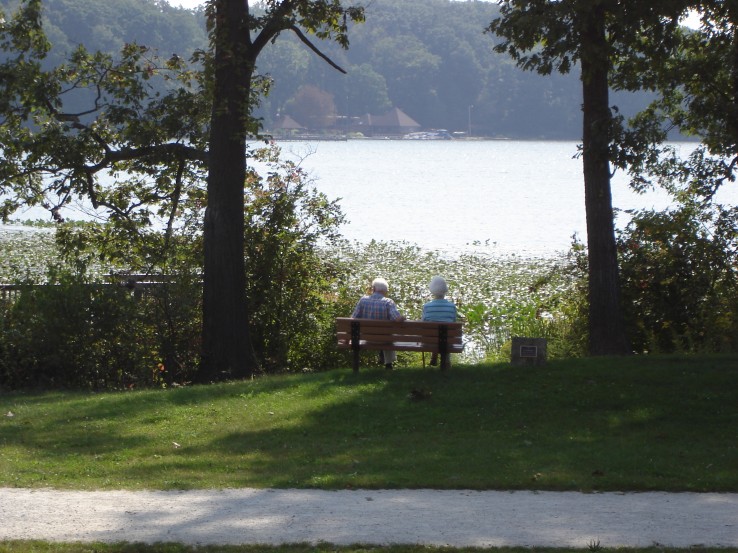On February 25, the NEOSCC Board voted unanimously to approve and endorse the Vibrant NEO 2040 Vision, Framework and Action Products. We are sharing an “Initiative A Day” so you can gain a better understanding of the vision and framework! If you would like to read all of the Initiatives, you can download them here: Recommendation and Initiatives. You can access a pdf of the entire vision chapter here. The vision chapter contains all 41 initiatives, development strategies, indicators, and matrices that identify how the recommendations, initiatives and indicators all relate.
Show your support for Vibrant NEO 2040 by adding your name to our Champions of Vibrant NEO 2040 list here.
INITIATIVE 7.1: EXPAND AND CONNECT THE EXISTING NETWORK OF PARKS, TRAILS, RIVERS, LAKES, AND NATURAL AREAS THROUGH CONTINUED PARTNERSHIPS WITH PRIVATE LAND OWNERS, LAND CONSERVANCIES, LAND TRUSTS, COMMUNITY MEMBERS, AND LOCAL GOVERNMENTS.
WHAT THIS MEANS. Northeast Ohio has an impressive legacy of thinking and acting big on its parks and recreation assets. From Cuyahoga County’s Emerald Necklace to the many conservation areas in rural areas of the region, evidence of fruitful partnerships between governments, land owners, and community organizations abound. The region should continue and expand upon this legacy of investing in parks and natural spaces.
Expanding the region’s parks and natural spaces will require coordination and mutual support of the work of Metroparks and local parks authorities, local governments, and land conservancies and trusts. Land conservancies are particularly valuable partners in this effort, as they act as an intermediary between private landowners and public entities, negotiating and holding easements on private properties. The easement process is entirely voluntary and deeply respectful of individual property rights; easements are carefully crafted in close consultation with landowners, who agree to forego all future development rights, in perpetuity.
Trails are also important elements of a region’s parks and natural spaces system. The region should fill gaps in the existing regional trail network, and consider constructing new trails to expand the network. Trails provide opportunities not only for active recreation, but also for commuting between regional centers, returning many benefits to the region and its communities. Northeast Ohio’s Towpath Trail is a good example of a regional trail linking parks and nature reserves, and connecting major regional centers.
WHY THIS IS IMPORTANT. In an urban region, availability of space for human recreation and habitat preservation is an important determinant of livability and attractiveness of place. Setting aside land for an accessible, integrated parks and natural space network is a necessary investment in the region’s future. Doing so strategically maximizes the impact of the investment by layering in additional functions, such as mobility or stormwater management.
GETTING IT DONE. Controlling the disposition of future conservation land and parkland beyond the existing boundaries of the region’s municipalities is an important question that no single type of entity in Northeast Ohio, public or private, is adequately positioned to manage on its own. Ownership of the initiative must ultimately come from the Cuyahoga Valley National Park, Metroparks authorities and land conservancies, though NEOSCC and regional planning partners can play an important role in convening and facilitating a regional partnership between these entities. Given the history of cooperation on parks and open space matters and the civic-mindedness of the region’s land conservancies, it is not anticipated that this process of interagency collaboration would be particularly difficult.
In addition to the broader regional policy coordination this initiative envisions, local governments, particularly townships and counties, should support the efforts of land conservancies and trusts by offering incentives such as tax rebates and tax abatements to landowners who agree to an easement, as well as supporting the organizations’ outreach efforts.
BEST PRACTICE: Mill Creek Preserve: Located in Boardman Township, the Mill Creek Preserve consists of over 300 acres of upland and wetland habitats. Formerly the Orvets Sod Farm, the Metroparks acquired the property using grants from the Clean Ohio Conservation Fund and Wetland Resource Restoration Sponsorship Program (WRRSP). Due to its location along Mill Creek and the presence of a regionally significant 102-acre forested wetland complex, the Metroparks identified this property for acquisition in order to protect these sensitive habitats.
PILOT PROJECT: Fry Farm Acquisition—Phase 1: This project provides for the acquisition of approximately 75 acres as the first phase of a three-phase acquisition for a 323-acre park. This purchase also provides for the planned Lower Middle Branch Trail, a 10-foot wide multi-use recreational trail extending north to Frank Esmont Park in Canton Township and to Monument Park in Canton.
PILOT PROJECT: Cleveland Lakefront Nature Preserve: an 88-acre former dredge disposal site on Lake Erie in Cleveland that has been converted into a nature preserve and recreational amenity. The site provides habitat for hundreds of species of birds, butterflies, and mammals and offers a 1.3 mile trail loop for visitors to enjoy the wildlife and views of Lake Erie and downtown Cleveland.
| Lead | Metroparks Authorities, Land Conservancies and Trusts; Municipalities, Townships, Counties; Councils of Governments |
| Target Community | Strategic investment areas, asset risk areas, cost risk areas |
| Implementation Complexity | Moderate |
These recommendations, initiatives, and products, are not one-size-fits all and some aspects of the initiatives won’t be applicable everywhere in the 12-county region. The Vibrant NEO 2040 Vision, Framework and Products are intended inspire and guide decision-making at the Metropolitan Planning Organization (MPO), Council of Government, and local levels to ensure that land use, transportation, and environmental considerations are simultaneously addressed by their processes. Ultimately, the implementation of Vibrant NEO 2040 is up to Northeast Ohio’s communities and residents. But regardless of the applicability of each initiative to any particular part of the region, the goal for each community within the Vision is the same: stability, prosperity, and a high quality of life for all of its residents.

